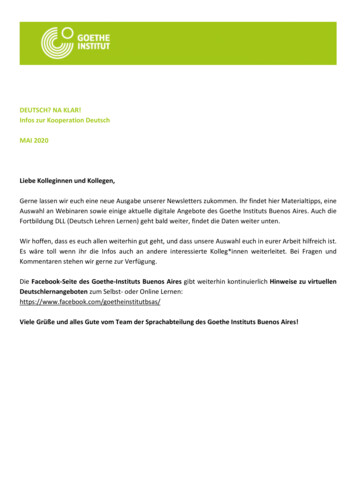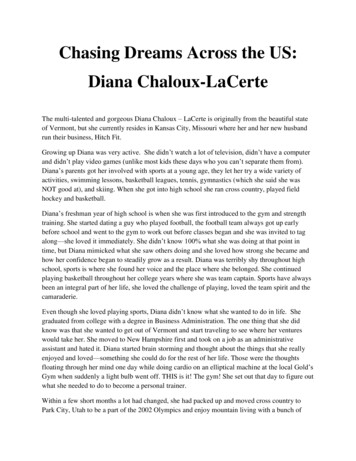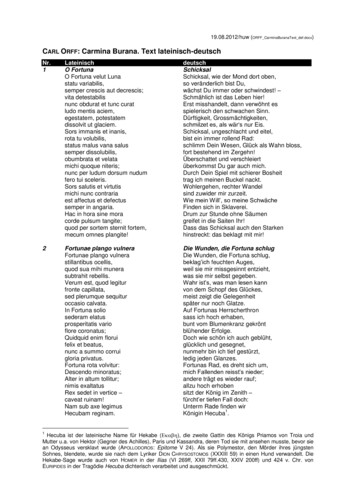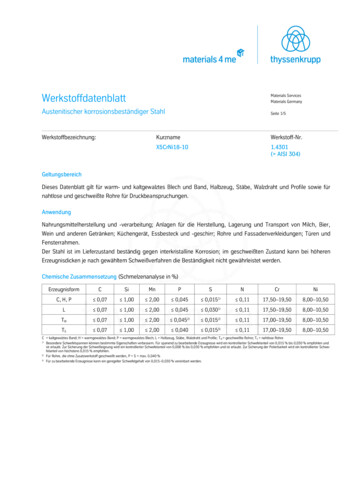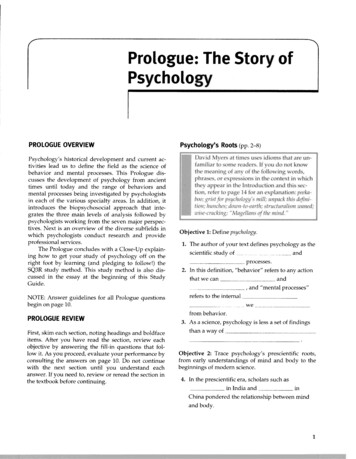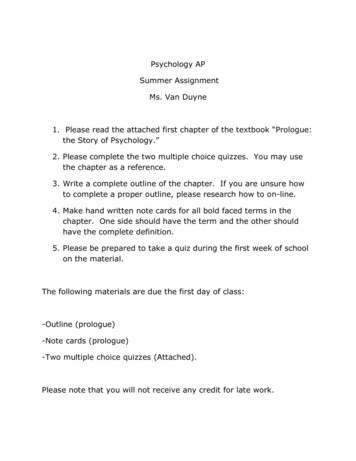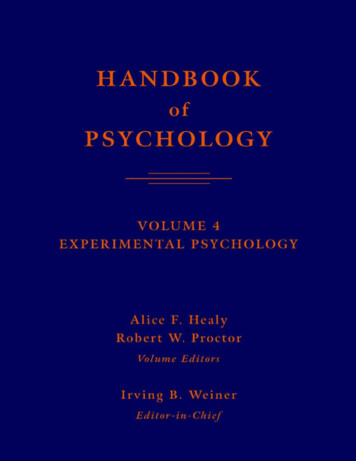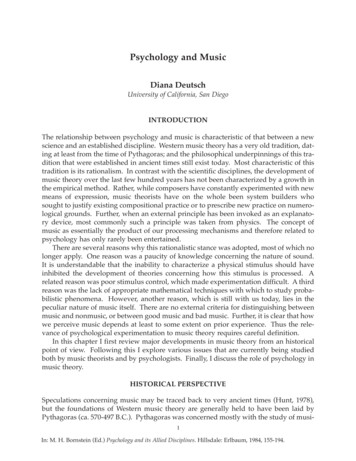
Transcription
Psychology and MusicDiana DeutschUniversity of California, San DiegoINTRODUCTIONThe relationship between psychology and music is characteristic of that between a newscience and an established discipline. Western music theory has a very old tradition, dating at least from the time of Pythagoras; and the philosophical underpinnings of this tradition that were established in ancient times still exist today. Most characteristic of thistradition is its rationalism. In contrast with the scientific disciplines, the development ofmusic theory over the last few hundred years has not been characterized by a growth inthe empirical method. Rather, while composers have constantly experimented with newmeans of expression, music theorists have on the whole been system builders whosought to justify existing compositional practice or to prescribe new practice on numerological grounds. Further, when an external principle has been invoked as an explanatory device, most commonly such a principle was taken from physics. The concept ofmusic as essentially the product of our processing mechanisms and therefore related topsychology has only rarely been entertained.There are several reasons why this rationalistic stance was adopted, most of which nolonger apply. One reason was a paucity of knowledge concerning the nature of sound.It is understandable that the inability to characterize a physical stimulus should haveinhibited the development of theories concerning how this stimulus is processed. Arelated reason was poor stimulus control, which made experimentation difficult. A thirdreason was the lack of appropriate mathematical techniques with which to study probabilistic phenomena. However, another reason, which is still with us today, lies in thepeculiar nature of music itself. There are no external criteria for distinguishing betweenmusic and nonmusic, or between good music and bad music. Further, it is clear that howwe perceive music depends at least to some extent on prior experience. Thus the relevance of psychological experimentation to music theory requires careful definition.In this chapter I first review major developments in music theory from an historicalpoint of view. Following this I explore various issues that are currently being studiedboth by music theorists and by psychologists. Finally, I discuss the role of psychology inmusic theory.HISTORICAL PERSPECTIVESpeculations concerning music may be traced back to very ancient times (Hunt, 1978),but the foundations of Western music theory are generally held to have been laid byPythagoras (ca. 570-497 B.C.). Pythagoras was concerned mostly with the study of musi1In: M. H. Bornstein (Ed.) Psychology and its Allied Disciplines. Hillsdale: Erlbaum, 1984, 155-194.
2DEUTSCHcal intervals. He is credited with identifying the musical consonances of the octave, fifth,and fourth with the numerical ratios 1:2, 2:3, and 3:4. He is also credited with establishing by experiment that the pitch of a vibrating string varies inversely with its length.However, Pythagoras and his followers ultimately lost faith in the empirical method andinstead attempted to explain all musical phenomena purely in terms of numerical relationships. As Anaxagoras (ca. 499-428 B.C.) declared: “Through the weakness of thesense-perceptions we cannot judge truth [Freeman, 1948, p. 86].” And later Boethius, theleading music theorist of the Middle Ages and a strong follower of Pythagoras, wrote inDe Institutione Musica:For what need is there of speaking further concerning the error of the senses when this same faculty of sensing is neither equal in all men, nor at all times equal within the same man? Thereforeanyone vainly puts his trust in a changing judgement since he aspires to seek the truth [Boethius,1967, p. 58].The view that music ought to be investigated solely by contemplation of numericalrelationships has characterized most music theory since Pythagorean times. On thisview, the world of mathematics is held to provide an ideal which the world of sense-perception can only imitate. Experimental procedures are therefore held to be irrelevant: ifthe results of experiments are in accordance with theory, then they are redundant; if theresults conflict with theory, then they must have been ill-conceived in the first place.Also stemming from the mathematical approach of the Pythagoreans have been thenumerous attempts to build entire musical systems by mathematical deduction from aminimal number of established musical facts. Essentially this approach derives from afalse analogy with geometry (Russell, 1945). Euclidean geometry begins with a fewaxioms which are held to be self-evident, and from these axioms arrives by deduction attheorems that are not in themselves self-evident. However, it is a logical error to assumethat we can proceed by deduction from one musical fact to another musical fact. Properly,musical facts can only be used as a basis for the formulation of hypotheses about furthermusical facts, which require empirical verification.Another strong influence on music theory which stemmed from the Pythagoreanswas the belief that the ultimate explanation of musical phenomena lies in physics. Untilthe Copernican revolution, this belief took the form of assuming that music serves as areflection of sounds produced by the heavenly bodies. As described by Aristotle in DeCaelo, it was thought:that the motion of bodies of that [astronomical] size must produce a noise, since on our earth themotion of bodies far inferior in size and in speed of movement has that effect. Also, when the sunand the moon, they say, and all the stars, so great in number and size, are moving with so rapid amotion, how should they not produce a sound immensely great? Starting form this argument, andfrom the observation that their speeds, as measured by their distances, are in the same ratio asmusical concordances, they assert that the sound given forth by the circular movement of the starsis a harmony [Aristotle, 1930, p.290].Figure 1 shows that Pythagorean view of the universe, in which the relative distancesof the heavenly bodies to each other are displayed, together with the musical intervalsformed thereby. It can be seen that the distance between the Earth and the Moon formed
PSYCHOLOGY AND MUSIC3a whole tone, from the Moon to Mercury a semitone, from Mercury to Venus a semitone,from Venus to the Sun a tone and a half, from the Sun to Mars a whole tone, from Marsto Jupiter a semitone, from Jupiter to Saturn a semitone, and finally from Saturn to theSupreme Heaven, a semitone. Notice further that the entire distance between Earth andthe Supreme Heaven formed an Octave.The theory of the Harmony of the Spheres was an attractive one, since it providedanswers to several fundamental questions about music. One question was why musicexists in the first place; and the answer provided was that it serves as a reflection of theDivine Harmony. A second question was why certain musical intervals (the consonances) strike us as pleasing while others do not; and the answer here was that the consonances are those intervals that are present in this Divine Harmony. The theory evenhad a normative value, since it provided boundary conditions for separating music fromnon-music.The main problem with the theory that puzzled the ancient Greeks (as well as thosewho followed) was why, if the heavenly bodies do indeed produce this harmony, we cannot hear it. One answer, suggested by Censorinus, was that the loudness of the sound isso great as to cause deafness1 (Hawkins, 1853/1963). An alternative view, described byAristotle (who did not in fact endorse it), was that since this sound is with us since birth,and since sound is perceived only in contrast to silence, we are not aware of its presence.However, neither of these views was considered satisfactory.At all events, the theory of the Harmony of the Spheres provided a strong link amongthe studies of music, astronomy, and mathematics, with the result that the scientific part ofthe program of higher education developed into the Quadrivium of the “related studies” ofastronomy, geometry, arithmetic, and music. The Quadrivium persisted through to the endof the sixteenth century and was responsible for much interaction between the disciplines.FIG. 1. Pythagorean view of the universe in musical intervals. (From Hawkins, 1853/1963.)1This view inspired Butler’s lines in Hudibras (Part II):Her voice, the music of the spheres,So loud it deafens mortal ears,As wise philosophers have thought,An that’s the cause we hear it not.[Butler, 1973, p. 122].
4DEUTSCHIn general, the later Greek theorists adhered to the numerological approach of thePythagoreans. There was, however, a notable exception. Aristoxenus (ca. 320 B.C.), originally a pupil of the Pythagoreans and later of Aristotle, saw clearly that music cannot beunderstood by contemplation of mathematical relationships alone. He argued that thestudy of music should be considered an empirical science and that musical phenomenawere basically perceptual and cognitive in nature. For example, in the Harmonic Elementshe wrote:The order that distinguishes the melodious from the unmelodious resembles that which we findin the collocation of letters in language. For it is not every collocation but only certain collocationsof any given letters that will produce a syllable.And later:It is plain that the apprehension of a melody consists in noting with both the ear and intellect everydistinction as it arises in the successive sounds-successive, for melody, like all branches of music,consists in a successive production. For the apprehension of music depends on these two faculties, sense-perception and memory; for we must perceive the sound that is present and rememberthat which is past. In no other way can we follow the phenomenon of music [Aristoxenus, 1902,pp. 192-194].But Aristoxenus was not understood by his contemporaries, nor by the music theorists of the Middle Ages and early Renaissance, who continued to adhere to the numerological approach. Most of his works were lost to posterity, though fortunately two booksof his Harmonic Elements and fragments of his Elements of Rhythmics were preserved.In violation of prevailing theoretical constraints, medieval polyphony employedintervals other than the pure consonances of the octave, fifth, and fourth allowed by thePythagoreans. It therefore fell to the theorists of the fifteenth and sixteenth centuries tojustify existing practice in the context of the Pythagorean doctrine. This was achieved byZarlino (1517-1590) who argued that the number six had various metaphysical properties. For example, it is the first perfect number (1 2 3 1 x 2 x 3 6). Zarlino proposed that the realm of the consonances be extended to combinations produced by ratiosformed by the first six numbers. This justified the use of the major third (5:4), minor third(6:5), and major sixth (5:3). (The minor sixth was also admitted somehow, although itsratio is 8:3.) In his heavily numerological and theological treatise, Istituzioni Armoniche(1558/1950), Zarlino developed rules of composition based on the concept of the first sixnumbers as a divinely ordained sanctuary containing the consonances (the scenario) outside of which the composer can wander only under severe restrictions. Thus theoreticalapproval was given to existing musical practice on numerological grounds, and a newset of boundary conditions for music was established (Palisca, 1961).The scientific revolution of the sixteenth and seventeenth centuries had a profoundeffect on music theory. First, advances in astronomy forced theorists to abandon the viewthat the universe was a harmony, and with it the view that musical consonances reflectthis harmony. Second, advances in understanding the properties of vibrating strings ledto a re-evaluation of the role of number in musical explanation: Numerical ratios werenow considered meaningful in that they applied to the properties of sounding bodies.Discovery of the overtone series, of the relationship between pitch and frequency, and of
PSYCHOLOGY AND MUSIC5the physical correlates of consonance and dissonance inclined some thinkers to adopt amore empirical approach to musical issues in general (Palisca, 1961).Notable among the musical empiricists of the sixteenth century were GiovanniBattista Benedetti (1530-1590) and Vincenzo Galilei (1520-1591).2 Benedetti was perhapsthe first to relate the sensations of pitch and consonance to rates of vibration. Galileidemonstrated by experiment that the association of the consonant intervals with simplenumberical ratios held only when their terms represented pipe or string lengths and alsowhen other factors were held constant. For example, these relationships did not hold forrelative weights of hammers, nor for volumes enclosed in bells. He also argued that disputes concerning tuning systems were futile, since the ear cannot detect the small pitchdifferences under debate. He proposed a new theory of counterpoint based on existingmusical practice, rather than on appeal to extra-musical phenomena, and he arguedstrongly for the empirical method in studying music. However, thinkers such as Galileiwere very much in the minority, and the prevailing theoretical stance continued to beheavily rationalistic.In parallel with scientific advances concerning the physical properties of sound3,composers of the late sixteenth and the seventeenth centuries were particularly active inexperimenting with new techniques. There thus arose a need for a new theoretical synthesis to justify prevailing musical practice and to link this with newly obtained scientific knowledge. This was achieved by the composer and music theorist Jean-PhilippeRameau (1683-1764). Rameau’s systematization forms the basis of traditional harmonictheory as we know it today. By analyzing the compositions of his predecessors and contemporaries and by joining to these analyses the resul
inhibited the development of theories concerning how this stimulus is processed. A related reason was poor stimulus control, which made experimentation difficult. Athird reason was the lack of appropriate mathematical techniques with which to study proba- bilistic phenomena. However, another reason, which is still with us today, lies in the peculiar nature of music itself. There are no .
